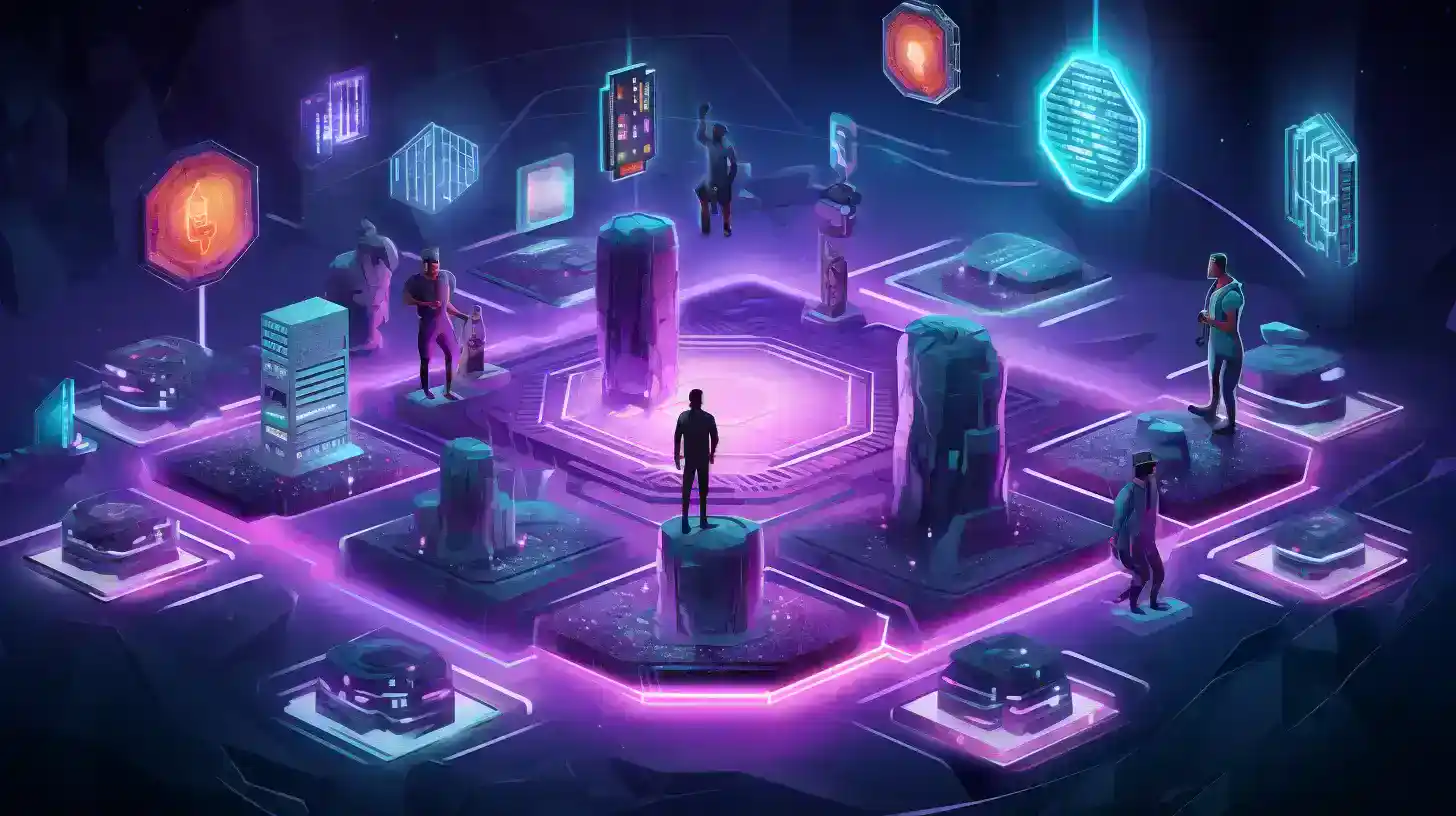Table of Contents
Introduction
The introduction lays the groundwork for an exploration of Web3, tracing the transformative phases of the internet from static to dynamic, and now, heralding the emergence of Web3 as the next paradigm shift. Promising to redefine how we interact, transact, and collaborate online, the article aims to delve into the fundamental concepts of Web3, encompassing its origins, key components, potential implications, and the challenges it faces.
This introduction effectively captures the essence of Web3 as a revolutionary force in the digital landscape, inviting readers to delve into a comprehensive examination of its multifaceted dimensions.
Understanding Web3: A Comprehensive Exploration

1. The Evolution of the Web
The journey towards Web3 begins with a retrospective examination of the web’s evolution. Web1, characterized by static HTML pages, marked the initial phase of the internet, offering limited interactivity and a one-way flow of information. This paved the way for Web2, an era defined by user-generated content, social media, and interactive web applications.
Despite its advancements, the centralized nature of Web2 platforms introduced concerns regarding data privacy, security, and centralized control.
2. Decentralization and Blockchain Technology
At the core of Web3 is the pivotal concept of decentralization, addressing the limitations of Web2. Blockchain technology emerges as the foundational building block, exemplified by cryptocurrencies like Bitcoin and Ethereum.
This decentralized and distributed ledger technology ensures secure, transparent, and tamper-resistant record-keeping, eliminating the need for intermediaries. The result is the inception of decentralized applications (DApps) operating on a peer-to-peer network, reducing reliance on central authorities.
3. Smart Contracts and Ethereum
Ethereum, positioned as the flagship of Web3, introduces the groundbreaking concept of smart contracts. These self-executing contracts revolutionize the way transactions occur by enabling trustless and automated processes, removing the necessity for intermediaries.
The programmable nature of smart contracts expands the realm of possibilities, from decentralized finance (DeFi) platforms reshaping traditional financial services to the creation and trading of non-fungible tokens (NFTs), representing unique digital assets.
Decentralized Finance (DeFi)
DeFi emerges as a transformative application of smart contracts within the Web3 ecosystem. By decentralizing financial services, DeFi platforms offer users greater inclusivity and control over their assets. Lending, borrowing, and trading can occur without the need for traditional intermediaries, potentially redefining the landscape of financial transactions.
Non-Fungible Tokens (NFTs)
NFTs represent a paradigm shift in the concept of digital ownership, facilitated by smart contracts. These unique digital assets, ranging from digital art to virtual real estate, have disrupted traditional notions of ownership and proven the potential of blockchain technology in revolutionizing the art and entertainment industries.
Key Components of Web3

Decentralized Identity (DID)
- User Empowerment: Decentralized Identity (DID) is a fundamental aspect of Web3 that aims to empower users by giving them control over their digital identities. This shift represents a departure from the traditional model where centralized entities manage and control user identities.
- Security Enhancement: DID enhances security in the digital realm by allowing users to securely manage their data. With the decentralization of identity, the risk of centralized data breaches is mitigated, providing users with greater confidence in the protection of their information.
- Authentication and Authorization: One of the key features of DID is its ability to reduce reliance on centralized entities for authentication and authorization. Users can independently manage access to their data without the need for intermediaries, enhancing privacy and autonomy.
- Privacy Focus: DID emphasizes privacy by design, ensuring that users can control what information is shared and with whom. This focus on privacy aligns with the growing concerns over data security and the need for user-centric solutions.
- User-Centric Approach: Web3’s emphasis on DID signifies a shift towards a more user-centric approach to identity management. Users are no longer just subjects of identity systems but active participants with control over their digital personas.
Interoperability and the Semantic Web
- The decentralized nature of Web3 has the potential to disrupt traditional industries. Smart contracts, decentralized applications, and blockchain technology can streamline processes, reduce costs, and eliminate the need for traditional intermediaries. This shift is evident in the ongoing transformation of finance through DeFi and the restructuring of digital asset ownership through NFTs.
- Seamless Interconnection: Web3 envisions a digital space where different platforms seamlessly interconnect, fostering a more integrated and accessible internet experience. This interconnectedness is crucial for breaking down barriers between diverse online environments.
- Semantic Web Extension: The Semantic Web serves as an extension of the current web, aiming to enhance the meaning and context of data. It provides a framework for data interoperability, allowing machines to understand and process information more effectively.
- Data Interoperability: The Semantic Web’s focus on data interoperability ensures that information can flow freely across various platforms, making it easier for users and machines to access and comprehend data regardless of its source.
- Machine Comprehension: With the Semantic Web, machines gain the ability to comprehend and interpret data in a more human-like manner. This advancement contributes to the development of intelligent systems capable of extracting meaningful insights from diverse data sources.
- Fluid Information Exchange: The goal of the Semantic Web is to create a digital environment where information exchange is fluid, eliminating silos between different platforms and enabling a more seamless user experience.
- Enhanced User Experience: Ultimately, the vision of an interoperable and semantic web is geared towards enhancing the overall user experience, making information more universally accessible and understandable.
Tokenization and Digital Assets
- Blockchain Facilitation: Tokenization, a key aspect of Web3, is facilitated by blockchain technology. This process involves representing real-world or digital assets as tokens on a blockchain, creating a new paradigm for ownership.
- Conversion of Assets: Tokenization involves the conversion of traditionally illiquid assets, such as real estate or art, into digital tokens. Each token represents a share or unit of ownership in the underlying asset.
- Fractional Ownership: One of the significant advantages of tokenization is the concept of fractional ownership. Users can own a fraction of an asset, making high-value assets more accessible to a broader range of investors.
- Increased Liquidity: By tokenizing assets, liquidity is increased as these digital tokens can be traded on blockchain-based platforms. This liquidity opens up new possibilities for dynamic and efficient markets. For businesses navigating this market, expert guidance through tokenomics consulting can provide invaluable insights into optimizing these opportunities.
- New Economic Models: Tokenization introduces new economic models, challenging traditional structures of ownership and investment. This shift has the potential to democratize access to various forms of assets, fostering a more inclusive financial ecosystem.
- Democratization of Access: Tokenization democratizes access to assets that were traditionally limited to a select few. This inclusivity aligns with the principles of Web3, aiming to reduce barriers and provide broader participation in financial markets.
- Revolutionizes Ownership Models: The tokenization of assets represents a revolutionary shift in ownership models, moving away from centralized and exclusive ownership structures towards a more decentralized and inclusive approach.
Decentralized Autonomous Organizations (DAOs)
- Smart Contract Governance: Governance within DAOs is often facilitated through smart contracts, self-executing code that enforces predefined rules. This ensures transparency and trust in the decision-making process.
- Decentralized Decision-Making: DAOs embody decentralized decision-making processes. Members collectively decide on key matters through consensus mechanisms, allowing for a more democratic and participatory approach to organizational governance.
- Enhanced Transparency: The use of smart contracts in DAOs enhances transparency. All decisions and transactions are recorded on the blockchain, providing an immutable and publicly accessible ledger of the organization’s activities.
- Trustless and Autonomous: DAOs operate in a trustless environment, where the execution of predefined rules occurs automatically through smart contracts. This autonomy reduces the need for trust in centralized authorities.
- Departure from Hierarchy: The organizational structure of DAOs represents a departure from traditional hierarchical models. Decision-making authority is distributed among the members, fostering a more egalitarian and inclusive approach.
- Participatory Decision-Making: DAOs exemplify a future where decision-making is participatory and distributed. Members actively contribute to the governance of the organization, aligning with the principles of decentralization championed by Web3.
Potential Implications of Web3

Empowering Users and Fostering Trust
- Web3’s emphasis on decentralization and blockchain technology empowers users by granting them greater control over their digital identity and data. The trustless nature of transactions ensures that users can engage in online activities without sacrificing privacy or security. This empowerment is a cornerstone of Web3’s vision for a user-centric digital landscape.
- Greater Data Control: Web3 has the potential to empower users by providing them with greater control over their data. Through decentralized identity solutions, individuals can manage their digital identities securely, ensuring a user-centric approach to online interactions.
- Digital Interaction Autonomy: Trustless systems in Web3 empower users to participate in online activities without sacrificing privacy or security. Users can engage in digital interactions with confidence, knowing that their data is under their control and transactions occur securely and transparently.
- Decentralized Identity Implementation: The implementation of decentralized identity solutions is a key aspect of user empowerment in Web3. It shifts the paradigm from centralized control to user autonomy, aligning with the vision of a more user-centric digital landscape.
- Privacy and Security Emphasis: The emphasis on privacy and security in Web3 ensures that users can navigate the digital realm without compromising their personal information. Trustless transactions further contribute to fostering a digital environment where users feel confident in their online engagements.
Disrupting Traditional Industries
- The decentralized nature of Web3 has the potential to disrupt traditional industries. Smart contracts, decentralized applications, and blockchain technology can streamline processes, reduce costs, and eliminate the need for traditional intermediaries. This shift is evident in the ongoing transformation of finance through DeFi and the restructuring of digital asset ownership through NFTs.
- Finance Transformation: The decentralized nature of Web3 has the potential to disrupt traditional industries, starting with finance. Smart contracts and blockchain technology in decentralized finance (DeFi) platforms are reshaping financial services, offering alternatives to traditional banking and investment models.
- Supply Chain Innovation: Web3’s impact extends to supply chain industries, where blockchain technology ensures transparent and tamper-resistant record-keeping. This innovation reduces inefficiencies, enhances traceability, and minimizes the need for intermediaries in supply chain processes.
- Entertainment Industry Evolution: The entertainment industry is also subject to disruption by the decentralized nature of Web3. NFTs, enabled by blockchain, have revolutionized digital ownership of creative content, impacting how artists, musicians, and other content creators monetize their work.
- Streamlined Processes: The potential disruption of traditional industries by Web3 is characterized by streamlined processes, reduced costs, and the elimination of intermediaries. This shift towards decentralized models contributes to a more efficient and accessible business environment.
Incentivizing Collaboration and Innovation
- Tokenization as Incentive: Tokenization, a core aspect of Web3, serves as a mechanism for incentivizing collaboration and innovation. Web3 platforms often utilize tokens to reward users for their contributions to the network, creating a symbiotic relationship between users and the success of the platform.
- Decentralized Incentive Mechanisms: Decentralized incentive mechanisms play a pivotal role in fostering collaboration and innovation. Users are motivated to contribute to the network’s growth, whether through content creation, development efforts, or other valuable contributions, as they are directly rewarded with tokens.
- Rewards for Contributions: The incentive structures within Web3 platforms go beyond traditional models, providing tangible rewards for users who actively contribute to the ecosystem. This approach aligns interests, encouraging a collaborative and innovative environment.
- Content Creation and Development Contributions: Incentivization extends to various contributions, including content creation and development. Users are recognized and rewarded for their creativity, skills, and efforts, creating a dynamic ecosystem where innovation flourishes.
In this transformative landscape, Web3 not only empowers individuals by giving them control over their digital presence but also reshapes industries, incentivizes collaboration, and paves the way for innovative economic models.
Challenges and Considerations

Scalability and Performance
- Blockchain Network Challenges: Web3 technologies, specifically blockchain networks, encounter significant challenges related to scalability and performance. The inherent design of blockchain, while providing security and decentralization, can lead to issues such as slow transaction times and high fees as the user base expands.
- Growing Network Users: The increasing number of users joining Web3 networks exacerbates scalability concerns. As more participants engage with blockchain applications and transactions, the demand for network resources intensifies, potentially hindering the system’s ability to handle the load efficiently.
- Mainstream Adoption Impediments: Scalability issues pose a potential impediment to mainstream adoption of Web3 technologies. The user experience is closely tied to the network’s ability to process transactions swiftly and cost-effectively. Slow transaction times and high fees may discourage users from fully embracing Web3 platforms.
- Exploration of Solutions: Addressing scalability challenges is an active area of exploration within the Web3 community. Various solutions, including layer 2 scaling solutions, aim to enhance the capacity and efficiency of blockchain networks, ensuring a smoother and more scalable experience for users.
Regulatory Uncertainty
- Evolving Regulatory Landscape: The regulatory landscape surrounding Web3 is in a state of constant evolution. Governments and regulatory bodies are navigating the complexities of decentralized technologies, leading to a level of uncertainty about how regulations will be applied.
- Government Approaches: Governments worldwide are in the process of determining their approaches to decentralized technologies. Striking a balance between fostering innovation and ensuring compliance with existing regulations poses a challenge, as lawmakers seek to understand and adapt to the unique characteristics of Web3.
- Crucial Innovation-Compliance Balance: Achieving a balance between innovation and compliance is crucial for the sustainable growth of Web3. While innovation is a driving force, compliance with regulatory frameworks is essential to establish a secure and trustworthy environment for users, businesses, and investors.
- Industry Collaboration: Ongoing collaboration between the Web3 community, industry stakeholders, and regulatory bodies is vital. This collaboration can contribute to the development of regulatory frameworks that foster innovation while addressing concerns related to security, consumer protection, and legal compliance.
User Experience and Accessibility
- Prioritizing User Experience: Widespread adoption of Web3 hinges on prioritizing user experience and accessibility. Overcoming the complexities associated with various aspects, including wallet management, private key security, and transaction processes, is essential to create a user-friendly environment.
- Wallet Management Challenges: Users often face challenges in managing their wallets, understanding private key security, and navigating the intricacies of transaction procedures. Simplifying these processes is crucial to lower entry barriers and enhance the overall user experience.
- Enhanced Accessibility: Improving accessibility is key to ensuring that a broader audience can engage with Web3 technologies. This involves designing intuitive interfaces, providing educational resources, and developing user-friendly applications that cater to both experienced users and newcomers.
- Educational Initiatives: Educational initiatives play a vital role in empowering users with the knowledge required to navigate the Web3 landscape confidently. By promoting awareness and understanding, users can participate more effectively in decentralized ecosystems.
In navigating these challenges, Web3 aims not only to revolutionize the technical infrastructure but also to create an environment that is user-centric, compliant with regulations, and accessible to a diverse global audience.
Conclusion
Web3 represents a paradigm shift towards a more decentralized, user-centric, and interconnected digital ecosystem. From blockchain technology and smart contracts to decentralized identity and DAOs, the components of Web3 are shaping the future of the internet.
As the journey continues, addressing challenges and fostering collaboration will be key to unlocking the full potential of the Web3 revolution.
For more such content also visit our blockchain insite page.